warning Oldsmobile Achieva 1997 s Owner's Guide
[x] Cancel search | Manufacturer: OLDSMOBILE, Model Year: 1997, Model line: Achieva, Model: Oldsmobile Achieva 1997Pages: 372, PDF Size: 18.52 MB
Page 218 of 372
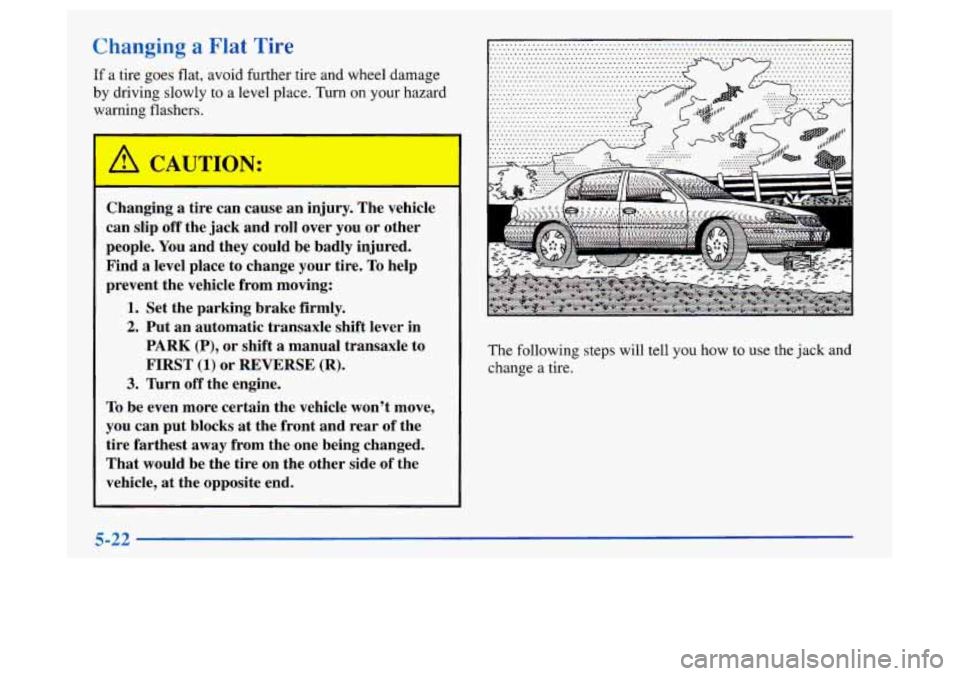
ianging a Flat Tire
If a tire goes flat, avoid further tire and wheel damage
by driving slowly
to a level place. Turn on your hazard
warning flashers.
Changing a tire can cause an injury. The vehicle
can slip off the jack and roll over you or other
people.
You and they could be badly injured.
Find a level place to change your tire. To help
prevent the vehicle from moving:
1. Set the parking brake firmly.
2. Put an automatic transaxle shift lever in
PARK (P), or shift a manual transaxle to
FIRST
(1) or REVERSE (R).
3. I'urn off the engine.
To be even more certain the vehicle won't move,
you can put blocks at the front and rear
of the
tire farthest away from the one being changed.
That would be the tire on the other side of the
vehicle,
at the opposite end. The following
steps will tell
you how to use the jack and
change a tire.
5-22
Page 247 of 372
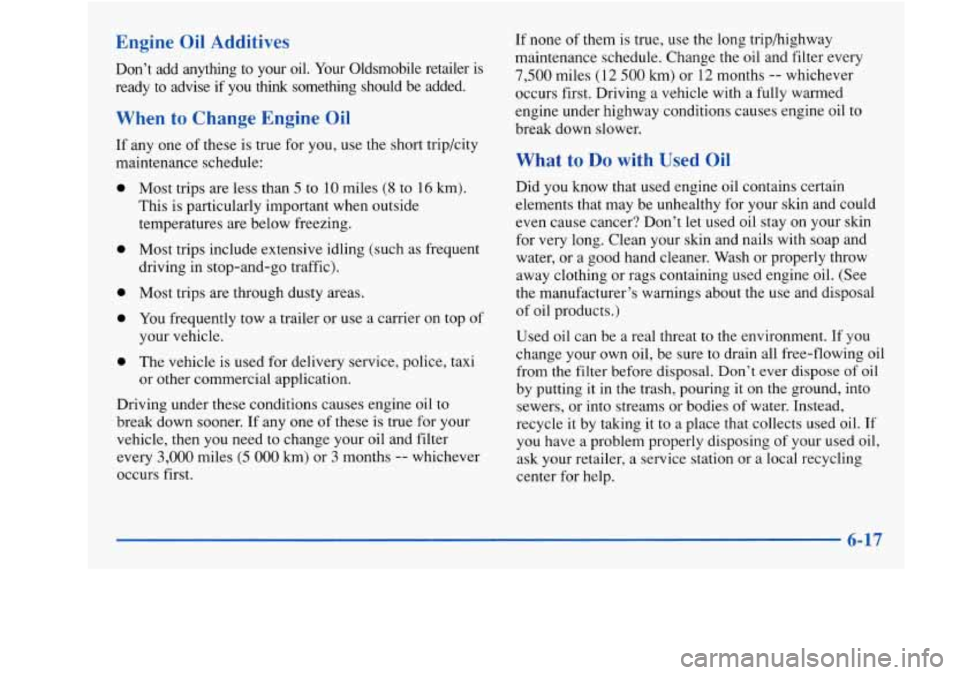
Engine Oil Additives
Don’t add anything to your oil. Your Oldsmobile retailer is
ready to advise if you think something should be added.
When to Change Engine Oil
If any one of these is true for you, use the short trip/city
maintenance schedule:
0
0
0
0
0
Most trips are less than 5 to 10 miles (8 to 16 km).
This is particularly important when outside
temperatures are below freezing.
Most trips include extensive idling (such as frequent
driving in stop-and-go traffic).
Most trips are through dusty areas.
You frequently tow a trailer or use a carrier on top of
your vehicle.
The vehicle is used for delivery service, police, taxi
or other commercial application.
Driving under these conditions causes engine oil to
break down sooner. If any
one of these is true for your
vehicle, then you need to change your oil and filter
every
3,000 miles (5 000 km) or 3 months -- whichever
occurs first.
If none of them is true, use the long triphighway
maintenance schedule. Change the oil and filter every
7,500 miles (1 2 500 km) or 12 months -- whichever
occurs first. Driving a vehicle with
a fully warmed
engine under highway conditions causes engine oil to
break down slower.
What to Do with Used Oil
Did you know that used engine oil contains certain
elements that may be unhealthy for your skin and could
even cause cancer? Don’t let used oil stay on your skin
for very long. Clean your skin and nails with soap and
water, or a good hand cleaner. Wash or properly throw
away clothing or rags containing used engine oil. (See
the manufacturer’s warnings about the use and disposal
of oil products.)
Used oil can be a real threat to the environment. If you
change your own oil, be sure to drain all free-flowing oil
from
the filter before disposal. Don’t ever dispose of oil
by putting
it in the trash, pouring it on the ground, into
sewers, or into streams
or bodies of water. Instead,
recycle it by taking it to a place that collects used oil.
If
you have a problem properly disposing of your used oil,
ask your retailer, a service station or a local recycling
center for help.
6-17
Page 254 of 372
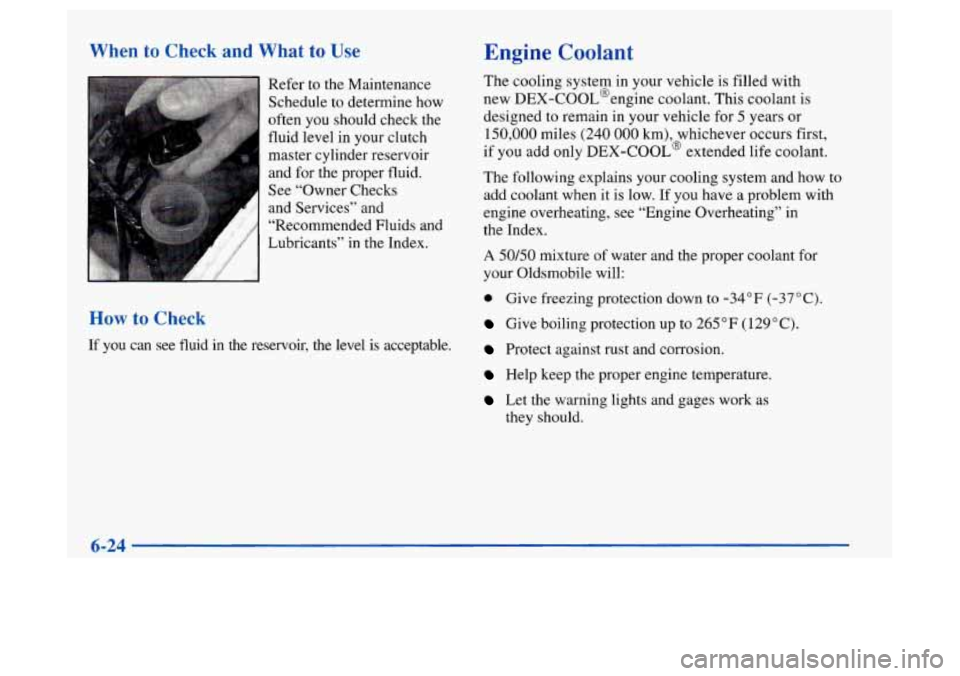
When to Check and What to Use
Refer to the Maintenance
Schedule to determine how
often you should check the
fluid level
in your clutch
master cylinder reservoir
and for the proper fluid.
See “Owner Checks
and Services” and
“Recommended Fluids and
Lubricants” in the Index.
How to Check
If you can see fluid in the reservoir, the level is acceptable.
Engine Coolant
The cooling system in your vehicle is filled with
new DEX-COOL@engine coolant. This coolant is
designed to remain in your vehicle for
5 years or
150,000 miles (240
000 km), whichever occurs first,
if you add only DEX-COOL@ extended life coolant.
The following explains your cooling system and how
to
add coolant when it is low. If you have a problem with
engine overheating, see “Engine Overheating’’ in
the Index.
A 50150 mixture of water and the proper coolant for
your Oldsmobile will:
0 Give freezing protection down to -34°F (-37°C).
Give boiling protection up to 265 “F (129°C).
Protect against rust and corrosion.
Help keep the proper engine temperature.
Let the warning lights and gages work as
they should.
Page 255 of 372
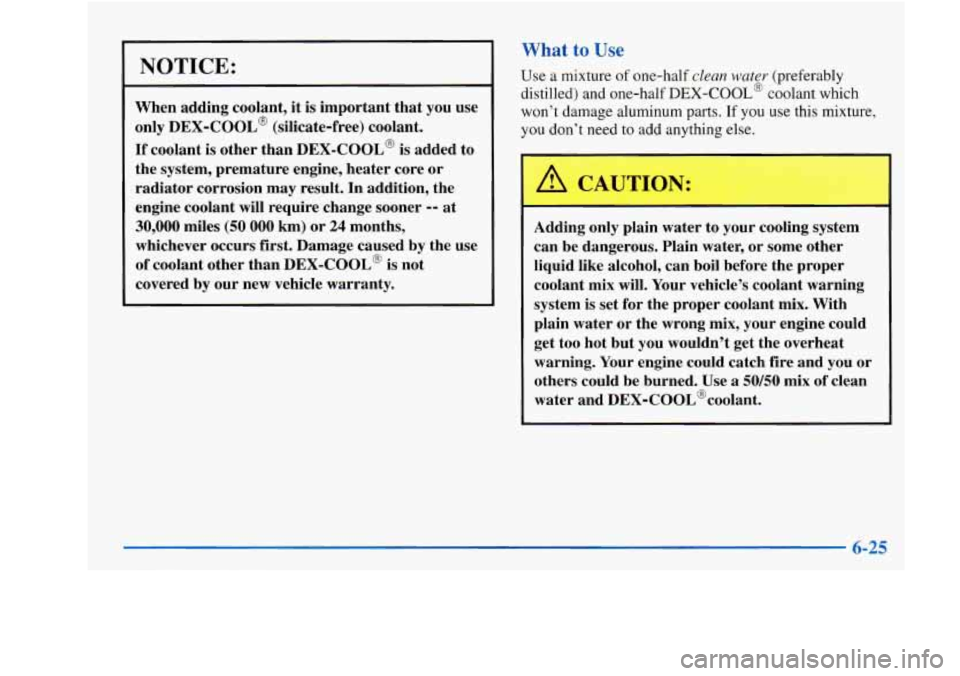
NOTICE:
When adding coolant, it is important that you use
only
DEX-COOL@ (silicate-free) coolant.
If coolant is other than DEX-COOL@ is added to
the system, premature engine, heater core or
radiator corrosion may result. In addition, the
engine coolant will require change sooner
-- at
30,000 miles (50 000 km) or 24 months,
whichever occurs first. Damage caused by the use
of coolant other than DEX-COOL’ is not
covered by our new vehicle warranty.
What to Use
Use a mixture of one-half clean water (preferably
distilled) and one-half
DEX-COOL@ coolant which
won’t damage aluminum parts.
If you use this mixture,
you don’t need
to add anything else.
Adding only plain water to your cooling system can be dangerous. Plain water, or some other
liquid like alcohol, can boil before the proper
coolant mix will. Your vehicle’s coolant warning
system is set for the proper coolant mix. With
plain water or the wrong mix, your engine could
get too hot but you wouldn’t get the overheat
warning. Your engine could catch fire and you or
others could be burned. Use
a 50/50 mix of clean
water and DEX-COOL%oolant.
Page 261 of 372

There are only two reasons why the brake fluid level in the
reservoir might go down. The first is that the brake fluid
goes down to an acceptable level during normal brake
lining wear. When new linings are put in, the fluid level
goes back up. The other reason is that fluid is leaking out
of the brake system.
If it is, you should have your brake
system fixed, since a leak means that sooner or later your
brakes won’t work well, or won’t work at
all.
So, it isn’t a good idea to “top off’ your brake fluid.
Adding brake fluid won’t correct
a leak. If you add fluid
when your linings
are worn, then you’ll have too much
fluid when you get new brake linings.
You should add
(or remove) brake fluid, as necessary, only when work is
done
on the brake hydraulic system.
If you have too much brake fluid, it can spill
on the engine. The fluid will burn if the engine
is hot enough. You or others could be burned,
and your vehicle could be damaged. Add brake
fluid only when work
is done on the brake
hydraulic system.
BRAKE
U.S. Canada
When your brake fluid falls to a low level, your brake
warning light will come on. See “Brake System Warning
Light” in the Index.
6-31
Page 263 of 372

Your Oldsmobile has front disc brakes and rear
drum brakes.
Disc brake pads have built-in wear indicators that make a
high-pitched warning sound when the brake pads are
worn and new pads are needed. The sound may come and
go or be heard all the time your vehicle is moving (except Some driving conditions or climates
may cause a brake
squeal when the brakes are first applied or lightly
applied. This does not mean something is wrong with
your brakes.
See “CaliperKnuckle Maintenance Inspection” in
Section
7 of this manual under Part C “Periodic
Maintenance Inspections.”
when you are pushing on the brake pedal firmly).
I
The brake wear warning sound means that soon
your brakes won’t work well. That could lead to
an accident. When you hear the brake wear
warning sound, have your vehicle serviced.
I NOTICE:
Continuing to drive with worn-out brake pads
could result in costly brake repair.
Properly torqued wheel nuts are necessary to prevent
brake pulsation. When tires are rotated, inspect brake
pads for wear and evenly torque wheel nuts in the
proper sequence to GM specifications.
Your rear drum brakes don’t have wear indicators, but
if
you ever hear a rear brake rubbing noise, have the rear
brake linings inspected. Also, the rear brake drums should
be removed and inspected each time the tires are removed
for rotation or changing. When you have the front brake
pads replaced, have the rear brakes inspected, too.
Brake linings should always be replaced as complete
axle sets.
See “Brake System Inspection” in Section
7 of this
manual under Part
C “Periodic Maintenance
Inspections”.
Page 275 of 372
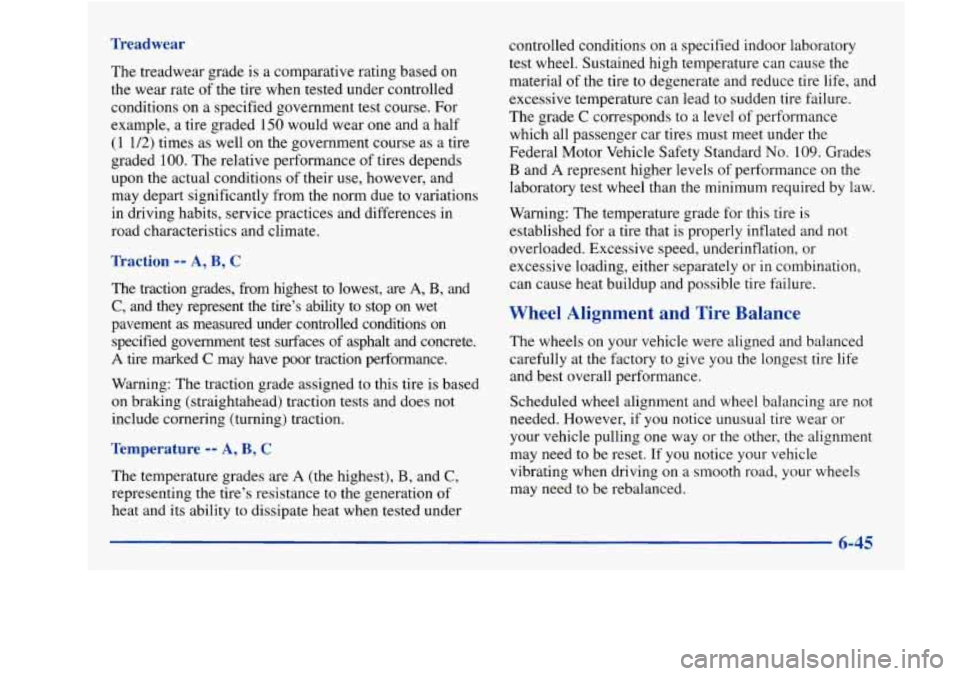
Treadwear
The treadwear grade is a comparative rating based on
the wear rate of the tire when tested under controlled
conditions on a specified government test course. For
example, a tire graded
150 would wear one and a half
(1 1/2) times as well on the government course as a tire
graded
100. The relative performance of tires depends
upon the actual conditions of their
use, however, and
may depart significantly from the norm due to variations
in driving habits, service practices and differences in
road characteristics and climate.
Traction -- A, B, C
The traction grades, from highest to lowest, are A, B, and
C, and they represent the tire’s ability to stop on wet
pavement as measured under controlled conditions on
specified government test surfaces of asphalt and concrete.
A tire marked C may have poor traction performance.
Warning: The traction grade assigned to this tire is based
on braking (straightahead) traction tests and does not
include cornering (turning) traction.
Temperature -- A, B, C
The temperature grades are A (the highest), B, and C,
representing the tire’s resistance to the generation of
heat and its ability to dissipate heat when tested under controlled
conditions on a specified indoor laboratory
test wheel. Sustained high temperature can cause the
material of the tire to degenerate and reduce tire life, and
excessive temperature can lead to sudden tire failure.
The grade
C corresponds to a level of performance
which all passenger car tires must meet under the
Federal Motor Vehicle Safety Standard
No. 109. Grades
B and A represent higher levels of performance on the
laboratory test wheel than the minimum required by law.
Warning: The temperature grade for this tire is
established for a tire that is properly inflated and not
overloaded. Excessive speed, underinflation, or
excessive loading, either separately or in combination,
can cause heat buildup and possible tire failure.
Wheel Alignment and Tire Balance
The wheels on your vehicle were aligned and balanced
carefully at the factory to give you the longest tire life
and best overall performance.
Scheduled wheel alignment and wheel balancing are not
needed. However, if you notice unusual tire wear or
your vehicle pulling
one way or the other, the alignment
may need to be reset. If you notice your vehicle
vibrating when driving on a smooth road, your wheels
may need to be rebalanced.
6-45
Page 278 of 372
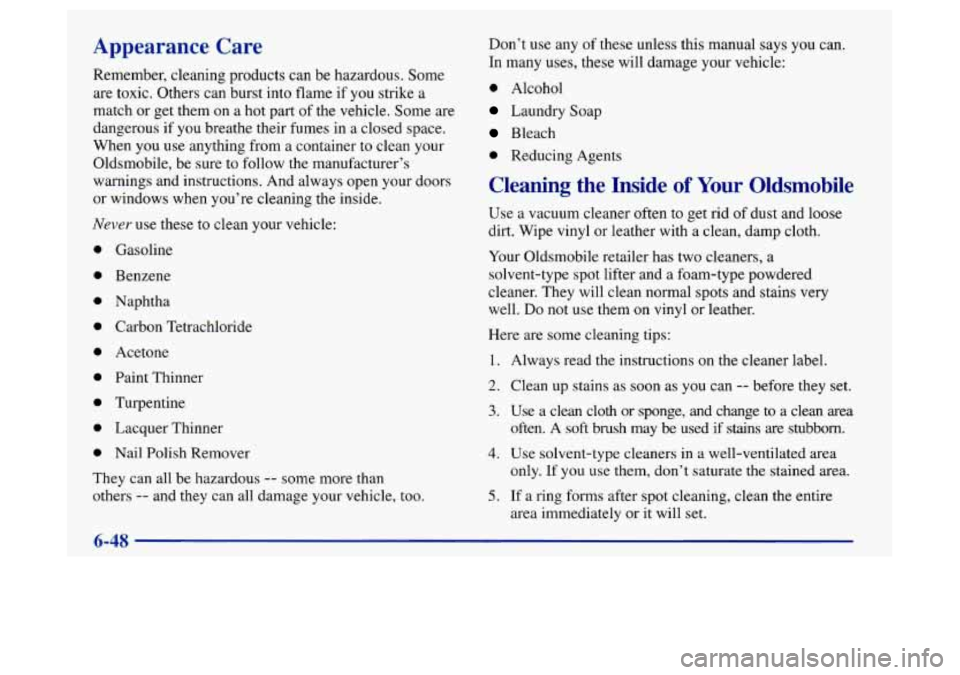
Appearance Care
Remember, cleaning products can be hazardous. Some
are toxic. Others can burst into flame if
you strike a
match or get them on a hot part of the vehicle. Some are
dangerous if
you breathe their fumes in a closed space.
When you use anything from a container to clean your
Oldsmobile, be sure to follow the manufacturer’s
warnings and instructions. And always open your doors
or windows when you’re cleaning the inside.
Never use these to clean your vehicle:
0
0
0
0
0
0
0
0
0
Gasoline
Benzene
Naphtha
Carbon Tetrachloride
Acetone
Paint Thinner
Turpentine
Lacquer Thinner
Nail Polish Remover
They can all be hazardous
-- some more than
others
-- and they can all damage your vehicle, too. Don’t
use any of these unless this manual says you can.
In many uses, these will damage your vehicle:
0 Alcohol
Laundry Soap
Bleach
0 Reducing Agents
Cleaning the Inside of Your Oldsmobile
Use a vacuum cleaner often to get rid of dust and loose
dirt. Wipe vinyl or leather with a clean, damp cloth.
Your Oldsmobile retailer has two cleaners, a
solvent-type spot lifter and a foam-type powdered
cleaner. They will clean normal spots and stains very
well.
Do not use them on vinyl or leather.
Here are some cleaning tips: 1. Always read the instructions on the cleaner label.
2. Clean up stains as soon as you can -- before they set.
3. Use a clean cloth or sponge, and change to a clean area
often. A
soft brush may be used if stains are stubborn.
4. Use solvent-type cleaners in a well-ventilated area
only. If you
use them, don’t saturate the stained area.
5. If a ring forms after spot cleaning, clean the entire
area immediately or it will set.
Page 288 of 372
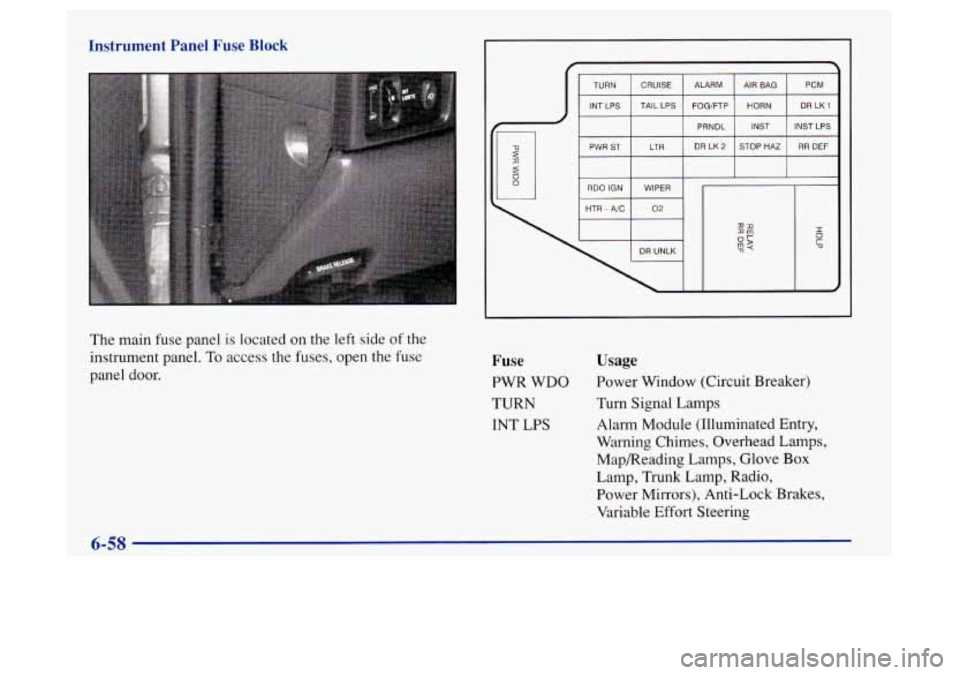
Instrument Panel Fuse Block
I
The main fuse panel is located on the left side of the
instrument panel.
To access the fuses, open the fuse
panel door. Fuse Usage
PWR WDO Power Window (Circuit Breaker)
TURN Turn Signal Lamps INT LPS Alarm Module (Illuminated Entry, Warning Chimes, Overhead Lamps,
MapReading Lamps, Glove
Box
Lamp, Trunk Lamp, Radio,
Power Mirrors), Anti-Lock Brakes,
Variable Effort Steering
Page 289 of 372
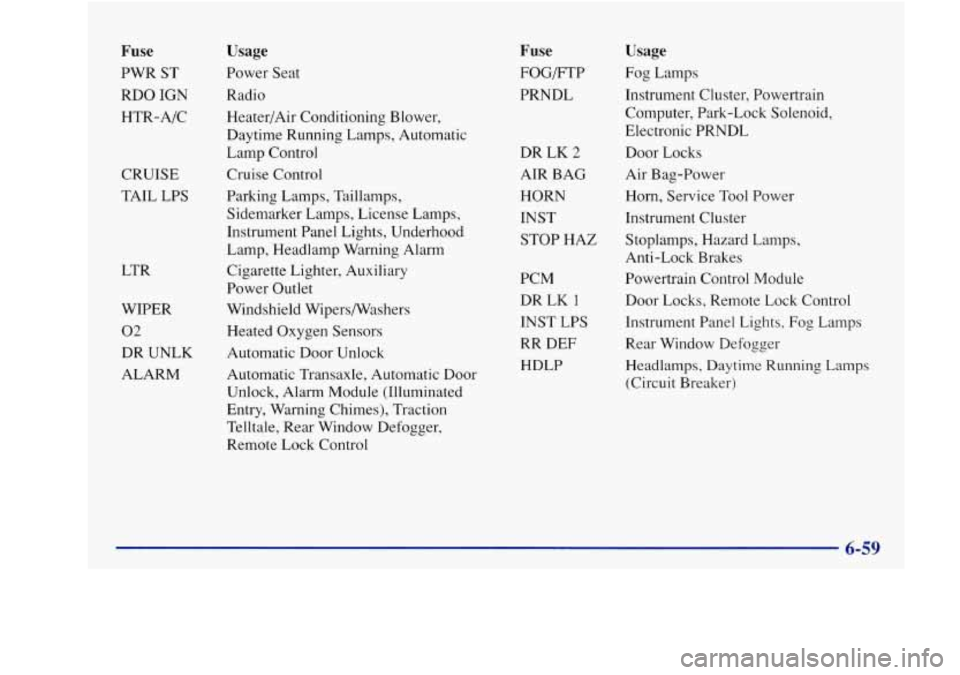
Fuse
PWR ST
RDO IGN HTR-A/C
CRUISE
TAIL LPS
LTR
WIPER
02
DR UNLK
ALARM
Usage
Power Seat
Radio
Heater/Air Conditioning Blower,
Daytime Running Lamps, Automatic
Lamp Control
Cruise Control
Parking Lamps, Taillamps,
Sidemarker Lamps, License Lamps,
Instrument Panel Lights, Underhood
Lamp, Headlamp Warning Alarm
Cigarette Lighter, Auxiliary
Power Outlet
Windshield Wipers/Washers
Heated Oxygen Sensors
Automatic Door Unlock
Automatic Transaxle, Automatic Door
Unlock, Alarm Module (Illuminated
Entry, Warning Chimes), Traction
Telltale, Rear Window Defogger,
Remote Lock Control
Fuse
FOG/FTP
PRNDL
DR LK
2
AIR BAG
HORN
INST STOP HAZ
PCM
DR LK
1
INST LPS
RR DEF
HDLP
Usage
Fog Lamps
Instrument Cluster, Powertrain
Computer, Park-Lock Solenoid,
Electronic PRNDL
Door Locks
Air Bag-Power Horn, Service Tool Power
Instrument Cluster
Stoplamps, Hazard Lamps,
Anti-Lock Brakes
Powertrain Control Module
Door Locks, Remote Lock Control
Instrument Panel Lights, Fog Lamps
Rear Window Defogger
Headlamps, Daytime Running Lamps (Circuit Breaker)